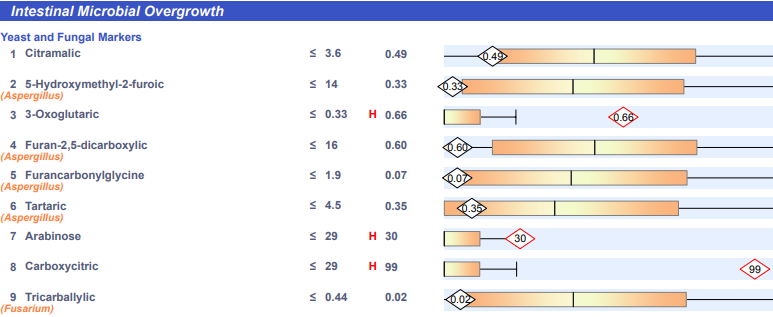The audio elaborates on the below images and testing. This is a broad overview and introduction.
“Walsh Labs”
To assess common biochemical imbalances in brain disorders and include bloodwork and a urine kryptopyrole test.
This sample report is from DHALab, which provides the Walsh/Pfeiffer Functional Range.
A Methylation Profile was referenced in the audio.
Urine Pyrrole Test
Basic Blood Work
These are labs often done as part of a routine physical.
Complete Blood Count
Depending on someones symptoms and history, I may check other thyroid measures, iron studies and B12.
Urine Mold Toxin Testing
The labs that I use is Real Time Lab (though there are others, many of us find this one to be the most reliable).
Sample Report:
Close up:
When a toxin is reading as present (and in some cases equivocal), that is considered a toxic level for which we recommend treatment. The test also provides tracking (of each toxin) over time. Normally we aren’t checking these monthly as this sample report shows.
Regarding the question I received about testing for ME/CFS/Chronic Fatigue Syndrome for someone struggling for 12 years and who has done Walsh testing, other nutrient testing, and genetic testing. I share the below linked study to emphasize how common mold toxicity is in ME/CFS, but also in most brain related conditions. (For the person who asked this questions, if you have had this test, I’m glad to elaborate with other testing to consider).
Detection of Mycotoxins in Patients with Chronic Fatigue Syndrome
Urine specimens from 104 of 112 patients (93%) were positive for at least one mycotoxin (one in the equivocal range). Almost 30% of the cases had more than one mycotoxin present. OTA (Ochratoxin) was the most prevalent mycotoxin detected (83%) with MT as the next most common (44%). Exposure histories indicated current and/or past exposure to WDB in over 90% of cases.
Organic Acid Test (Urine)
This is just the first page of an Organic Acid Test (or a Microbial Organic Acid Test) by Mosaic (formerly Great Plains Lab).
There is a lot more to this test, that goes beyond this introductory post.
Heavy Metals Testing (urine)
Sample Report from Doctor’s Data
Stool Testing
Though there are other labs I also use, this is one of them. Below is a summary page of Genova’s GI Effects Test (there are a number of pages that follow)
Genetic Testing
There are a number of labs that offer genetic testing. If someone has a23 and Me, it is possible to run the raw data through specific sites to get a methylation and other reports. This person’s data was run through a site called Genetic Genie.
Other tests that I use, though less frequently, include food sensitivity testing, IGenix testing for Lyme and it’s coinfections bartonella and babesia, hormone testing (either through bloodwork or the Dutch test) and testing for viruses.
If after seeing/listening to this, you have any questions that arise, please feel free to ask me below or email me at ms@courtneysnydermd.com.

















